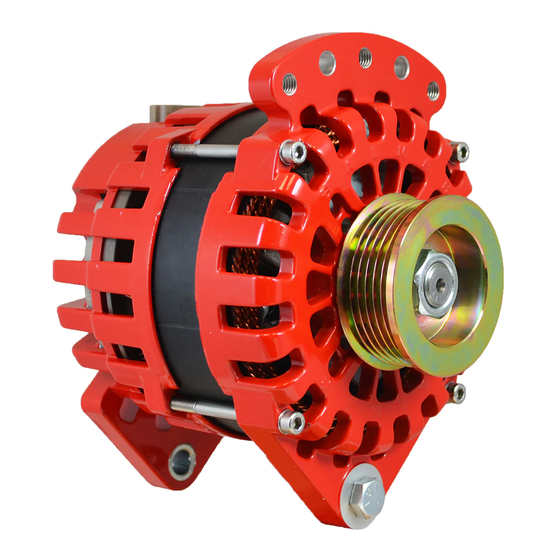Balmar 97 Series Manuel d'installation et d'utilisation - Page 4
Parcourez en ligne ou téléchargez le pdf Manuel d'installation et d'utilisation pour {nom_de_la_catégorie} Balmar 97 Series. Balmar 97 Series 20 pages. Alternator

PULLEYS
Most small case alternators rated at 100 amps or less come standard with a
single groove 2.5" deep vee pulley. The deep vee pulley is designed to pro-
vide optimal power transfer for belts measuring 3/8" (10mm) to 1/2" (13mm),
as measured across the back of the belt. Keep in mind, 3/8" and 7/16" belts
may sit low in the pulley sheave. This will not adversely affect the belt's per-
formance.
Higher output alternators in small, large and extra-large case series are
equipped standard with 1/2" dual groove or flat "Serpentine-style" multi-groove
pulleys. Should your application require a different pulley than that provided as
standard, Balmar may carry an optional pulley more suited to your needs. For
a list of optional pulleys, visit http://www.balmar.net/pulleymatrix.htm, or call
Balmar Customer Service at +1-360-435-6100.
ALTERNATOR HEAT
During operation, your alternator will become hot as a result of friction and the generation of inductive current. In
some instances, particularly during extended periods of heavy load, alternator case temperature can exceed 200
degrees (F). If your system is operating with a Balmar multi-stage voltage regulator with optional Alternator Tem-
perature Sensor (MC-TS-A), the regulator will automatically reduce field output if temperatures exceed set safe
working limits. While this is an extremely effective protection for the alternator, it should not be depended upon as a
part of normal operation. Correction of conditions causing overheating are strongly advised.
NOTE: If installing a MC-TS-A Temperature Sensor, do not bend the lug when mounting it to the alternator, or dam-
age may result. Do not hold onto the shrink-wrapped section of the lug when tightening down the bolt. See the ap-
propriate Balmar regulator manual for complete details.
Use extreme caution when handling the alternator or other engine components during or after use. Should your
alternator become so hot that it emits a burning smell, or if there is indication of discoloration at the pulley or pulley
shaft, shut off the alternator immediately and (once it becomes safe to inspect the alternator) check the tension of
the drive belt. Under- and over-tensioned belts are the leading cause of overheating and alternator damage. See
the Troubleshooting section, later in the manual, for alternator inspection guidelines.
FUSING
The American Boat and Yacht Council (ABYC), in its standards for safer boating, recommends that cable runs to
your battery banks be fused to protect the boat and owner against damage and injury. Circuit protection, as de-
scribed by ABYC standards, can be accomplished by installing either a resettable circuit breaker or a fuse. The fuse
or breaker you choose will depend on both the amperage rating of the alternator and the size of cable used. The
following considerations can be used to determine fusing:
1. The largest available circuit protection device smaller than the amperage capacity of the cable being protected.
2. Larger than the maximum continuous current that will flow in the circuit.
We find that a circuit protection device sized at approximately 140% of your alternator's rated amperage is typically
suitable for the circuit being protected. For more info about circuit fusing, see http://circuitwizzard.bluesea.com.
ALTERNATOR-TO-BATTERY RATIOS
In order to achieve optimal performance from your charging system, it is essential to determine the capacity your
charging system is capable of supporting. In general, the size rating of the alternator should mirror the acceptance
rate of the batteries being charged. Differing battery technologies will vary in terms of their acceptance rates. For
example, a deep-cycle flooded battery is typically capable of accepting roughly 25 percent of its available capacity
at any given time. As a result, we want our alternator's rated output to equal the acceptance rate of the battery being
charged when it reaches its full discharge rate.
In other words, a deeply discharged 400 amp hour deep cycle flooded battery would require an alternator rated at
25 percent of 400 amps, or 100 amps to support that bank. In simpler terms, a deep-cycle flooded battery bank will
require 25 amps of alternator output for every 100 amp-hours of battery rating. Some newer battery technologies,
such as AGMs and spiral wound batteries can accept about 40 percent, and LiFePo4 100% or more of their avail-
able capacities. Alternator output should be increased to reflect the optimal ratio between alternator and battery
capacity. Failure to meet recommended alternator-to-battery ratios will commonly result in slower charge times,
increased alternator heat and wear, and reduced alternator life.
Page
4
